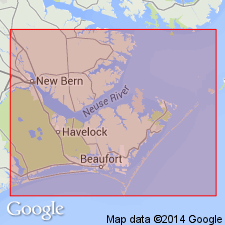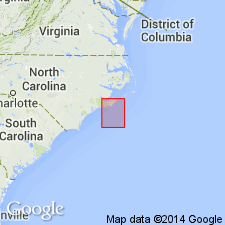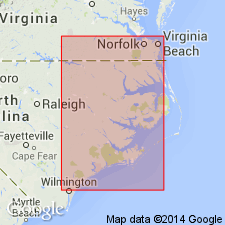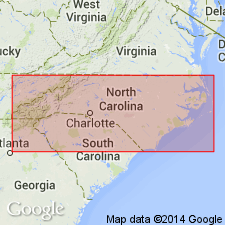
- Usage in publication:
-
- Flanner Beach Formation
- Modifications:
-
- Named
- Dominant lithology:
-
- Clay
- Sand
- AAPG geologic province:
-
- Atlantic Coast basin
Summary:
In the past, the Neogene (post-Oligocene) deposits exposed along Neuse Estuary downstream from New Bern have been divided into a Pliocene formation (Croatan) and a Pleistocene formation (Pamlico or Chowan). Older (Pliocene?) deposits are herein redefined and named James City Formation. "Pamlico" is rejected as a stratigraphic term and late Pleistocene deposits of lower Neuse Estuary, which unconformably overlie James City beds are referred to Flanner Beach Formation (here named). Lithology of the formation is variable laterally and vertically. Commonly composed of unconsolidated clays, sandy clays, argillaceous sands, and peaty sands and clays. Sedimentary sequence is that of a transgressive-regressive cycle. Five phases of cycle recognized: basal transgressive, upper transgressive, transgressive-regressive, basal regressive, and upper regressive. Thickest exposed section about 35 ft.
Source: GNU records (USGS DDS-6; Reston GNULEX).

- Usage in publication:
-
- Flanner Beach
- Modifications:
-
- Not used
- AAPG geologic province:
-
- Atlantic Coast basin
Summary:
Terms "Pamlico Formation" and "Flanner Beach Formation" have been used for deposits herein termed Neuse Formation. Flanner Beach includes deposits of Horry Clay and Pliocene Croatan Formation and is not a distinct lithologic unit.
Source: GNU records (USGS DDS-6; Reston GNULEX).

- Usage in publication:
-
- Flanner Beach Formation*
- Modifications:
-
- Revised
- AAPG geologic province:
-
- Atlantic Coast basin
Summary:
Flanner Beach Formation of DuBar and Solliday (1963) adopted for use by the USGS and stratigraphically restricted to exclude their Minnesott Ridge sand and other younger Pleistocene beds. Includes three informally named members: Beard Creek silty sand member, Arapahoe sand member and correlative Newport sand member. Unconformably overlies Yorktown Formation. Age is Pleistocene (pre-Sangamonian?).
Source: GNU records (USGS DDS-6; Reston GNULEX).

- Usage in publication:
-
- Flanner Beach Formation*
- Modifications:
-
- Revised
- Areal extent
- AAPG geologic province:
-
- Atlantic Coast basin
Summary:
Flanner Beach Formation revised to include sediments previously assigned to Neuse Formation (here abandoned). Type sections of both formations are across the Neuse River from each other and they are the same unit.
Source: GNU records (USGS DDS-6; Reston GNULEX).

- Usage in publication:
-
- Flanner Beach Formation
- Modifications:
-
- Revised
- Geochronologic dating
- AAPG geologic province:
-
- Atlantic Coast basin
Summary:
Flanner Beach Formation is subdivided into several newly named or newly formalized members. In its type area along the lower reaches of the Neuse River, the Flanner Beach is divided into the Smith Gut Member (new), the Arapahoe Sand Member (formalized), and the Beard Creek Member (formalized). To the south, the formation includes the Newport Sand Member (formalized). To the north, along the Pamlico River valley, the three members that compose the Flanner Beach are the Hills Point Member (new), the Mauls Point Member (new), and an unnamed member resembling the Beard Creek. Age is middle Pleistocene based on uranium-series and amino acid dating of fossils. Unit is thought to be about 200,000 years old. Disconformably overlies the James City Formation (700 ka to 1.0 Ma) . Correlative with the Great Bridge Formation of southeastern VA and with the Socastee Formation of southeastern NC and northeastern SC.
Source: GNU records (USGS DDS-6; Reston GNULEX).
For more information, please contact Nancy Stamm, Geologic Names Committee Secretary.
Asterisk (*) indicates published by U.S. Geological Survey authors.
"No current usage" (†) implies that a name has been abandoned or has fallen into disuse. Former usage and, if known, replacement name given in parentheses ( ).
Slash (/) indicates name conflicts with nomenclatural guidelines (CSN, 1933; ACSN, 1961, 1970; NACSN, 1983, 2005, 2021). May be explained within brackets ([ ]).

